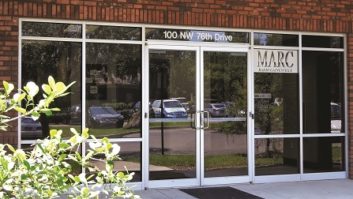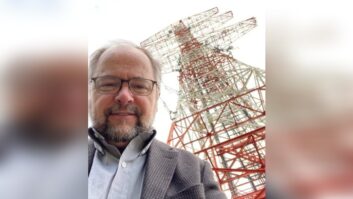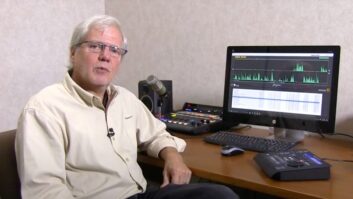This is one in a series of articles on the fundamentals of FM transmission systems.
Little thought is given to proper transmission line installation in many cases. A bag of cable ties or a box of Wraplock in the tower rigger’s pouch is deemed sufficient to secure the line to the tower. Most radio engineers have seen transmission line installations where little more than electrical tape or cable ties were used to secure the line.
While such inexpensive measures will work in the short term, over a period of time, trouble likely will result. Cable ties deteriorate with exposure to sunlight and extreme temperatures, becoming brittle, breaking and falling off. Thermal expansion/contraction as well as other differential motion between tower and line can cause Wraplock to chafe against the outer jacket, often resulting in the outer jacket and eventually the outer conductor being cut through. Once this happens the inside of the line is exposed to the elements.
By the book
Transmission line manufacturers offer an array of mounting hangers, brackets and hardware designed to protect lines from differential motion problems and keep them working properly for many years. In addition to the hardware, line manufacturers publish specifications for mounting hardware, including recommended spacing between hangers for different wind load and radial ice values.
The published values are not simply theoretical numbers or designed to promote the sale of hardware. They have been derived from extensive empirical data – including wind-tunnel testing – and are based on EIA RS-222, Structural Standards for Steel Antenna Towers and Antenna Supporting Structures.
Where a tower is located has an impact on the installation of a transmission line on the tower. Values of design basic wind speed, the maximum wind speed at a height of 10 meters over open terrain, are published for counties and states in EIA TIA-222-E. This is a good place to start when considering what hardware to use in a particular installation.
The maximum amount of radial ice accumulation is another factor that must be considered when designing a transmission line installation. Some locations, particularly those in the southern tier of states, are prone to ice storms and large accumulations of ice on tower structures and attachments. Warm, moisture-laden air rides up and over cold surface air and falls as rain. When the supercooled raindrops impact the surface and objects on the surface, they instantly freeze.
It is not uncommon to have an inch or more of radial ice build up on a tower structure, its antennas and lines in such circumstances, greatly increasing the dead weight and cross-section (and thus wind loading) of the tower, antennas and lines.
With the design basic wind speed and maximum expected amount of radial ice in hand, the manufacturer’s installation charts can be consulted to determine the type of hanger which should be used and the recommended maximum hanger spacing for a particular line. The quantity of hangers then can be calculated.
Hang it up
The next step is to determine how the hangers will be attached to the tower structure. Many towers provide mounting tabs to which hangers can be bolted directly. This is the simplest means of attachment, and provides for secure mounting.
Another means of mounting utilizes hose clamps or some other means of leg attachment. The hose clamp, sometimes called a “round member adapter,” clamps to the tower leg and to the hanger itself through a slot in the hanger. When using this attachment method, especially with larger diameter transmission lines, some means must be provided to get around the flanges where tower sections mate. Specially made standoff kits are available from line manufacturers to provide a means of getting the line securely past flanges without allowing the line to chafe against the flanges.
Hoisting grips are “Chinese handcuff” devices that are designed to attach to a transmission line securely and pull it up the tower without stretching or distorting the line. Typically, one hoisting grip should be used every 200 feet to spread out the load. This helps keep the weight of the line on the load line and off the line itself. Once the line is in place on the tower, the hoisting grips are secured to the tower to provide permanent vertical support.
It is important to “ground” a transmission line to the tower at both top and bottom and in some cases at several locations along the line’s length. When lightning hits the tower, high-level currents will flow down the tower in all the available parallel paths, including in the outer conductors of transmission lines.
Because copper has a lower DC resistance than the steel of the tower, greater currents are prone to flow in the transmission line outer conductors than in the tower steel. This often results in significant potential developed between the transmission line outer conductor and the tower itself, resulting in arc-through of the transmission line outer jacket and pitting of the transmission line outer conductor.
In extreme cases, the pitting actually will penetrate the outer conductor, opening the line to the elements and eventually destroying the line. Grounding or “bonding” the transmission line to the tower at frequent intervals is a good means of keeping the potential between the line and tower low and preventing such damage.
Other considerations
AM towers are a special case. Depending on the feed system, there are several methods of installing a transmission line on an AM tower. In grounded-base (skirted or shunt-fed) towers, the method essentially is the same as with any other tower, except that more frequent bonding of the line to the tower should be done to minimize RF arcs through the line jacket.
There are two basic means of installing transmission lines on insulated-base AM towers. If an isocoupler or isocoil is used, installation above the base insulator is the same as for a grounded-base tower. If a quarter-wave stub is used, the line is installed using insulated hangers. In that case, the line is not bonded to the tower at any location below the shorting stub.
Rigid transmission lines are another special case. Rigid lines are fixed to the tower at the top of the run and mounted in spring hangers for the remainder of the vertical run. A nylon-jacketed collar is provided on each spring hanger to prevent horizontal motion. A spring connects the collar to a clamp that is affixed to the line below the collar. The manufacturer provides recommended settings for the springs to ensure that the correct amount of tension is applied to the line at each location.
The purpose of the springs is to allow differential motion between the line and tower structure because of thermal expansion. A rigid copper transmission line exhibits considerably more thermal expansion than a steel tower. If this is not allowed for, the line will buckle.
In the next installment of this series, we will wrap up the topic of FM transmission lines with a discussion of pressurization, maintenance and repairs.







